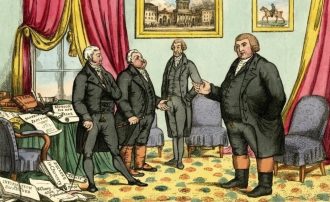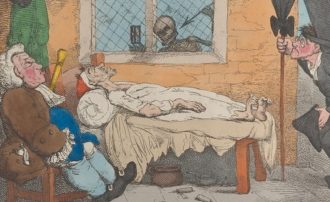

A View of the Four Courts © The Trustees of the British Museum. Shared under a Creative Commons Attribution-NonCommercial-ShareAlike 4.0 International (CC BY-NC-SA 4.0) licence.
Analysis: Caricatures and satirical prints lampooning the legal profession for its chicanery were hugely popular in Georgian Dublin
In a recent case regarding a dispute around commercial property in Galway, Mr Justice Michael Twomey highlighted the fact that lay litigants are being misled by dubious legal practitioners in the Irish courts. The High Court judge said that "quack lawyers" were causing delays on a daily basis and remarked on the reputational damage and "systematic harm" that is being caused to the Irish legal profession as a result of pseudo legal practitioners. There has been concern over this practice in the Dublin courts since 2008, yet unqualified legal practitioners continue to operate in "plain sight".
Though Justice Twomey's statements are in regards to the Irish legal profession in 2025, the judiciary has had to deal with the reputation of quack lawyers for several centuries. Though it is possible to retrace instances of legal chicanery in the written record, visual sources from Georgian Dublin provides a different perspective on attitudes towards the legal profession.
An examination of caricatures produced in Regency Dublin indicates that the city also had an issue with pettifogging attorneys, or at least suggests a market for such images. In A sharp between two flats, which was sold by William McCleary in Dublin sometime between 1810 and 1820, an immaculately dressed lawyer is shown settling a dispute between two unnerved litigants. Handing both parties empty oyster shells, the lawyer gleefully retains the oyster for himself. A metaphor for the avaricious nature of legal practitioners pitting unsuspecting litigants against each other, this caricature is only one example of the numerous visual satires against the legal profession in Georgian Dublin.

William McCleary's 'A Sharp between two flats'. Image: The Board of Trinity College Dublin (L)
Alexander McDonald 'The First Day of Term or, The Devil among the Lawyers'. Image: The Board of Trinity College Dublin (R)
According to contemporary newspapers, Dublin was gripped by a "mania" for caricatures in the late eighteenth and early nineteenth century. Legal caricature was one such genre of single sheet graphic satire sold by print sellers in the main shopping thoroughfares of Dublin from the 1790s to the late 1820s.
In London, the market for caricature was experiencing a golden period in production and consumption, with the latest designs attracting sizeable crowds around printshop windows. As a result, entrepreneurial Irish print sellers attempted to capitalise on interest in this novel commodity by reproducing English caricatures under their own name or designing original images which appealed to the Irish market. The print depicting the lawyer retaining the oyster for himself is an example of an English design plagiarised and sold to an Irish audience.
Another example is evident in The First Day of Term or the Devil among the Lawyers, which was sold by the artist Alexander McDonald sometime in the early nineteenth century. Here, the Devil distributes case briefs which read "To encourage Perjury £20" and "Putting off from Term to Term to increase Costs" to a crowd of eagerly waiting barristers. A case document visible in the foreground notes that one dispute began in 1699 but was not yet finished in the courts.
This is another reproduction of an English design, which indicates that satirical prints lampooning the legal profession were popular amongst Irish print buyers in Georgian Dublin. Often pictured in cahoots with the Devil, or carrying out the work of the Devil, it is evident that lawyers were favoured as subjects of public derision in caricature.
However, Irish print sellers also depicted specific members of the Irish judiciary to cash in on local affairs. In A view of the Four Courts, four Irish judges; William Downes, Thomas Manners-Sutton, John Toler and Standish James O'Grady engage in conversation as a sizeable workload of cases piles up behind them. William Laffan and Silvia Beltrametti have recently noted how McCleary and another Dublin print seller James Sidebotham were engaged in a legal dispute in the Irish courts for many years. This stemmed from McCleary allegedly passing off some of Sidebotham’s original prints as his own designs.

'Giving up the ghost or one too many' by William McCleary. Image: Medical Historical Library, Harvey Cushing/John Hay Whitney Medical Library, Yale University
In his recent warning about dubious legal practitioners, Justice Twomey noted how it would not be acceptable for hospital operating theatres to be occupied on the advice of quack doctors. Though medicine as a profession in Ireland has undergone significant advancement in the past several centuries, quack doctors with doubtful medical expertise also operated in Georgian Dublin. James Kelly notes how the Irish medical market space was rife with charlatans, as the price of physicians and surgeons was unaffordable for the majority of Irish society. As a result, McCleary's print Giving up the ghost or One too many indicates the popularity of doctors as sources of ridicule for Irish print buyers in this period.
Just like Justice Twomey has emphasised the reputational danger that "quack lawyers" are inflicting on the Irish judiciary, concerns surrounding the public effects of graphic satire are apparent in newspaper reports from the early nineteenth century. In 1789, the Freeman's Journal cautioned the public against caricatures which ridiculed "all professions, all ranks and degrees" as a danger to Irish society. This is indicative of the visibility of graphic satire in Georgian Dublin and its power to shape or reinforce public attitudes towards specific cohorts in society.
The author's PhD project examines how members of the legal and medical professions were depicted in image and text in late 18th and early 19th-century Dublin and is supported by Research Ireland
